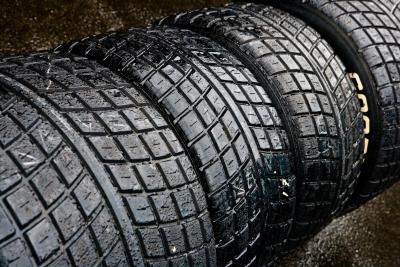
Directional tires are designed to provide better tire performance throughout the entire driving experience. Directional tires enhance straight acceleration and cornering maneuverability during both wet and dry driving conditions. A directional tire provides more adequate traction than a standard radial, which improves stopping distances and reduces the rolling effect that standard radials sometimes produce. It is important to note that if you are switching to directional tires, the spare tire also must be switched to a directional tire.
Mount the wheel face up on the tire mounting machine. Press the appropriate lever to lock the wheel onto the tire mounting machine.
Set one of the directional tires vertically on top of the rim. Lubricate the bead of the tire on one side, using a container of bead lubricant and applicator brush. The bead of a tire is the inner portion of the tire that contacts the wheel. It is important to lubricate the inner lip of the bead and approximately two inches out on the side of the bead to properly mount tires. Spin the tire around and lubricate the opposite bead using the lubricant and brush.
Lay the tire on its side with one bead down and one bead up. Take note of which bead you face up on each tire. Visually locate the white sticker or bar code on the inner lip of the tire. If the tire is missing the bar code, note what position the "D.O.T." number is facing. "D.O.T". numbers are on only one side of a tire. When mounting directional tires you need to remember to mount two "D.O.T." numbers up and two "D.O.T." numbers down.
Push the downward facing bead of the tire down over the lip of the rim, closest to the tire machine mounting arm. The tire should now be sitting at a 45-degree angle with the top bead facing the mounting arm on the machine. Set the adjustments on the mounting machine arm so that the arm is inside the upper bead and near the lip of the wheel.
Tilt the tire so that the bead is resting underneath the front of the mounting arm adapter, and above the rear of the mounting arm adapter. This position on the adapter will force the tire over the lip of the wheel. Depress the rotation pedal on the mounting machine to push the entire downward-facing bead onto the wheel completely.
Completely remove the mounting arm from the wheel and tire assembly for readjustment. Push the upward-facing bead on the tire so that it is sitting below the lip of the wheel, closest to the mounting arm. Align the mounting arm with the lip of the wheel. Set the tire so that the bead sits beneath the front of the mounting arm adapter and above the rear of the mounting arm adapter.
Place one mounting bar between the tire and the underside of the wheel lip, in front of the tire mounting arm. Hold the bar with your left hand. Hold the mounting arm in place with your right hand as you depress the rotation pedal to spin the tire for mounting. The tire will spin clockwise, and you need to keep the mounting bar in your left hand pressed between the tire and wheel, so follow the tire around with your left hand. Stop rotating the tire when the tire has rotated about 1/4-turn.
Double check the mounting arm with your right hand to make sure it is still pressed near the wheel. Insert a second mounting bar in front of the mounting arm, between the underside of the lip on the wheel and the bead of the tire. At this point you are going to force both mounting bars downward with your arms while simultaneously depressing the rotation pedal on the mounting machine. Follow the tire around with your body so that the mounting bars stay in place between the wheel and tire, until the tire is completely mounted onto the rim.
Install an air nozzle onto the valve stem of the wheel. Lubricate the upward-facing bead with the bead lubricant. Lift the tire upward with your arms while simultaneously depressing the tire inflate pedal completely down to the floor. Depressing the pedal to the floor causes a burst of air to be forced in between the downward facing bead and wheel. The force of this air will cause the bottom bead to seat on the wheel, while you are seating the upper bead with your arms. Inflate the tire to the manufacturer's recommendation, based on the vehicle.